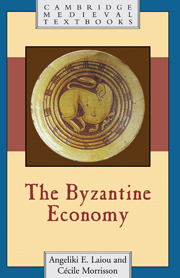Book contents
- Frontmatter
- Contents
- List of maps
- List of figures
- List of tables
- Acknowledgements
- List of abbreviations
- Introduction
- I Natural and human resources
- II The Late Antique economy and the shift to medieval structures (sixth–early eighth centuries)
- III Restructuring, recovery and controlled expansion (early eighth to tenth centuries)
- IV The age of accelerated growth (eleventh and twelfth centuries)
- V Small-state economics (from sometime in the thirteenth century to the fifteenth century)
- VI The Byzantine economy as exemplar; the Byzantine and the Western medieval economies
- Select bibliography
- Index
- Cambridge Medieval Textbooks
II - The Late Antique economy and the shift to medieval structures (sixth–early eighth centuries)
Published online by Cambridge University Press: 05 June 2012
- Frontmatter
- Contents
- List of maps
- List of figures
- List of tables
- Acknowledgements
- List of abbreviations
- Introduction
- I Natural and human resources
- II The Late Antique economy and the shift to medieval structures (sixth–early eighth centuries)
- III Restructuring, recovery and controlled expansion (early eighth to tenth centuries)
- IV The age of accelerated growth (eleventh and twelfth centuries)
- V Small-state economics (from sometime in the thirteenth century to the fifteenth century)
- VI The Byzantine economy as exemplar; the Byzantine and the Western medieval economies
- Select bibliography
- Index
- Cambridge Medieval Textbooks
Summary
In the first half of the sixth century, the Byzantine economy went through the last flourishing period of the Late Antique Roman civilization. It stood in sharp contrast with the West where most of the regions were severely affected by invasions, civil wars and social unrest in the fifth century, while the former imperial unified government was replaced by fragmented, often unstable and competing, barbarian kingdoms which maintained only partly the administrative and legal Roman traditions. The longer resilience of the Roman institutions and economy in the East was due to a virtuous circle of political stability and economic prosperity that enabled it to buy off or fight enemies in the Balkans while maintaining a by and large peaceful equilibrium in the east with Persia. These general comments are not applicable to every region and will be qualified below, when we examine the considerable differences in wealth and settlement between Illyricum and the eastern prefectures. Following Justinian's reconquest of North Africa and Italy, part of the Roman West was reunited with the East, a development which created a revival of Mediterranean trade. The costly long war against the Ostrogoths (535–55) and the devastation it caused in Italy have long been considered a major error of policy and a waste of state resources. Such criticism, however justified by the Byzantines' inability to defend the greatly extended territory, does not take into account the benefits which accrued to Byzantium in the long run from the recovery of the resources of southern Italy and Sicily.
- Type
- Chapter
- Information
- The Byzantine Economy , pp. 23 - 42Publisher: Cambridge University PressPrint publication year: 2007



